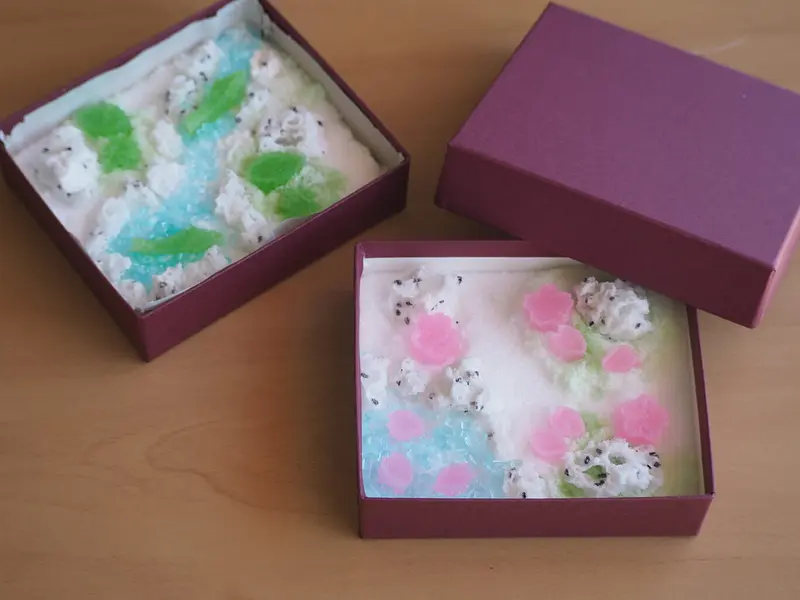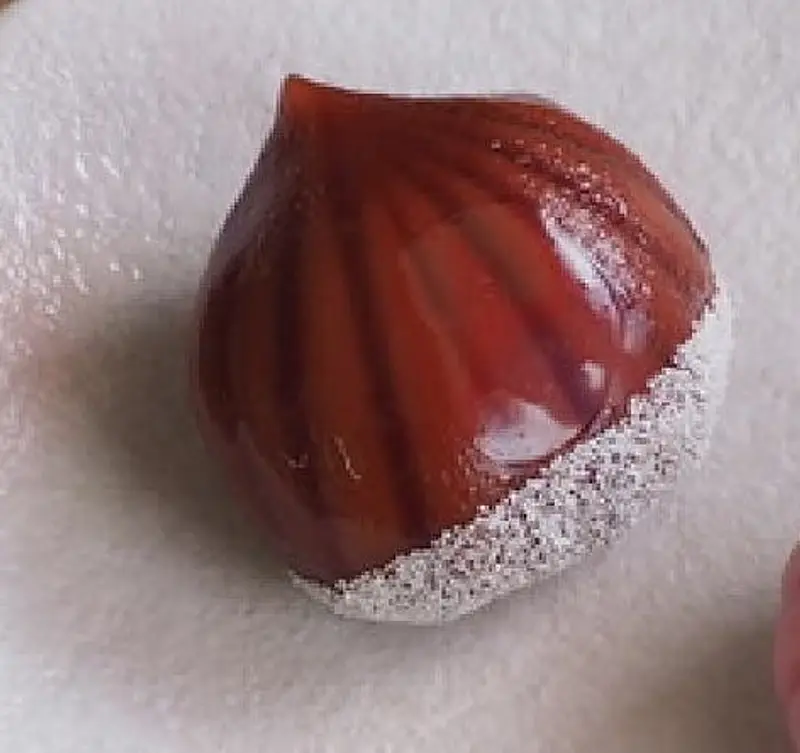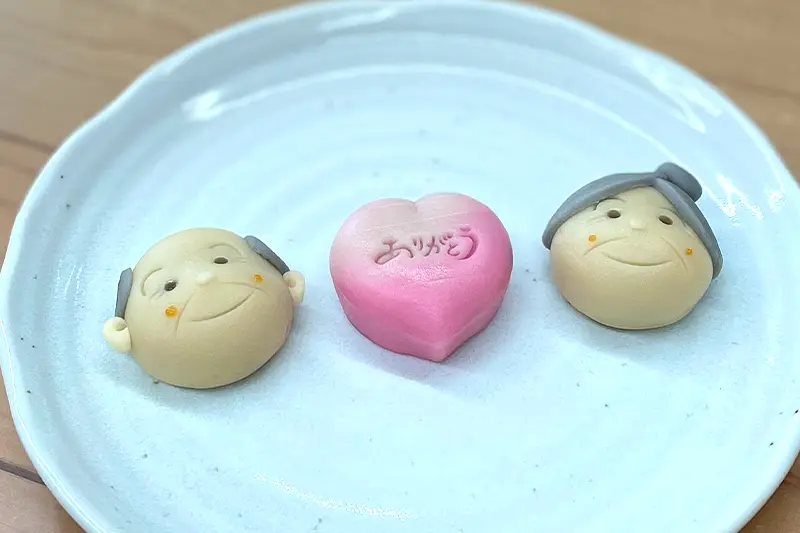[Founded in Meiji 24] Iwashimaya - Stunning Japanese sweets made by the young seventh generation
掲載日:2023.10.23
Iwashimaya KomonoTown creates Instagram-worthy Japanese sweets created by a seventh-generation Japanese sweets craftsman while preserving the traditional taste that has been passed down for over 100 years. We are particular about ingredients such as azuki beans from Tokachi, Hokkaido and domestic wheat flour, and each piece is carefully crafted to bring out the original taste and flavor of the ingredients. Cute seasonal confectionery attracts the hearts of the younger generation.
“Kuribao” is a collaboration between Japanese and Western sweets using chestnuts.
A baked confectionery made of rice cake and chestnut paste wrapped in pie. Chestnut paste with a buttery scent. It will be even more delicious if you rebake it in your toaster at home.
Daifuku Monaka using chestnut kinton in autumn
"Daifuku Monaka" is a popular product from Iwashimaya. Sandwich the daifuku, which is fresh cream wrapped in sweet bean paste, in the middle. In autumn, fresh cream is wrapped in chestnut kinton. Chestnut Kinton and fresh cream go great together, and if you eat it with the separately packaged sakusaku monaka, you can enjoy the textures of fresh cream, chestnuts, mochi, and monaka.
column
There is also an October limited Halloween set.
These Halloween-themed sweets include pumpkins and ghosts that will make you say, "Is this Japanese sweets? How cute!" Before you eat, take a photo and post it on social media.
Japanese sweets class also held
Mr. Shibata, the seventh generation, started the Japanese sweets class because he wanted to break away from the image of Japanese sweets as being difficult to get into and to make them more familiar. Anyone can participate by reservation. The sweets we make change every month. The participants on this day were one man, a first-grade elementary school boy, and his mother. This time, we made sweets called ``Chestnut Gathering'' and ``Himegiku''. Here you can see how chestnut pickers are made. Please slide the photo to see. The steps are as below.
① Wrap the rolled takoshian in nerikiri, which is made by kneading white bean paste with sugar, yam, and other binders, and shape it into a chestnut shape. Use a special tool to add lines that will create a chestnut pattern. (3rd image)
② Pour the liquid yokan batter over it. (4th image)
③ Once the yokan is dry, add crushed sticky rice to it. (5th image)
○ Participation fee: 1,500 yen per person
○ Children under 3rd grade of elementary school must be accompanied by a guardian
○ What to bring: Apron, sling, mask
*We will prepare a pack for you to take home.
We are sending out detailed information about our Japanese sweets class on Instagram and official LINE. You can make a reservation from the official LINE.
Traditional taste usukawa manju
Locals say, ``When you think of Iwashimaya, you think of usukawa manju,'' a popular product that has been made using the same method since its founding. This sake manju is made from alcoholic acid and has a dough that smells like alcohol, filled with homemade sweet bean paste. This is a masterpiece that takes three days to make by repeating fermentation and aging of sticky rice.
column
Cute Christmas fresh sweets available in December
While valuing tradition, the seventh generation makes use of their youthful sensibilities to create Japanese sweets that Generation Z will want to try their hand at. Japanese sweets are becoming more accessible.
Lots of seasonal sweets too
Strawberry daifuku is popular from winter to spring. Slide the photo to see other seasonal Japanese sweets.
The second photo is Hanami Dango and Sakura Mochi. I want to take it to cherry blossom viewing and eat it. Next is the water manju with a jiggly texture. Iced strawberry bars are delicious in midsummer. Since it is made from kudzu, it will not become liquid even if it takes a long time to eat. It is safe to feed to small children as it will not dissolve.
The fifth photo is chestnut kinton, which I want to eat at least once in autumn. This is the 6th photo of the fresh sweets that you want to eat with your grandparents on Respect for the Aged Day. There are also cute Onijo fresh sweets. What I want to eat on Valentine's Day is Nama Chocolate Daifuku. How about rewarding yourself for your hard work?
“Komogaku Festival 2023” is an event in KomonoTown where Iwashimaya’s workshop is held.

Iwashimaya will also have a stall at “Komogaku Festival 2023” which will be held from October 28th to 29th, 2023.
We will be holding a workshop called ``Sato Garden'' at Komo Gaku Juku, where you can have a variety of experiences. Create your own miniature garden using sugar with different grain sizes, brightly colored and soft amber sugar, and carmela, which is hard and resembles a rock. You can also learn about the different types of sugar and how they are used, including caster sugar, granulated sugar, zarame sugar, and wasanbon sugar.
○Suitable for ages 3 and over
○Fee: 2,000 yen
○There will be 5 sessions held each day with a capacity of 5 people each session.
For more information on Komo Gaku, please see the report article ``Introducing the charms of Komono's Komo Gaku Festival where you can see, eat, and touch''. Check the link below
About Iwashimaya access and parking lot
310 Ikesoko, Komono-cho, KomonoTown Mie 510-1221
○Access by car: Approximately 10 minutes from Shin-Meishin Expressway “Komono IC”
○Parking lot located to the east of the store
○TEL 059-393-2465
○Closed on Mondays
Click here for the official website
We post information on events, Japanese sweets classes, etc. on our official Instagram and official LINE.
Click here for official Instagram
Click here for official LINE






